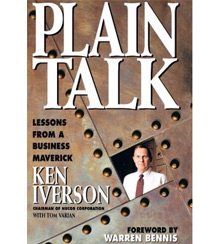strategy+business, January 7, 2019
 by Theodore Kinni
by Theodore KinniTwenty years ago, in 1998, my agent called and asked if I’d be interested in coauthoring a business book aimed at identifying 21 companies that would lead the way in the 21st century. If you know anything about the vagaries of prediction, you can imagine what a lesson in humiliation that gig turned out to be. (Oh, 3Com; oh, Nokia.) But on the plus side, the project introduced me to F. Kenneth Iverson, a highly successful corporate leader who isn’t nearly as well remembered today as he should be — and whose simple and clear directives from the late 20th century resonate clearly in the 21st century.
At the time, Iverson’s memoir/management exposition, Plain Talk: Lessons from a Business Maverick, was newly published. And he was chairman of Nucor Corporation, which, under his leadership, had come from nowhere to run circles around Big Steel and compete head-to-head with heavily subsidized foreign steelmakers.
Iverson, born in 1925, revolutionized the steel industry. But that wasn’t his initial intent. In 1965, he was a vice president at Nuclear Corporation of America, a profitless company in which he headed a unit making steel joists. As bankruptcy loomed, the board fired the company’s president and offered Iverson the position. “Apparently, managing the only profitable division in the company made me presidential material,” he recalled in Plain Talk. “Although I was just 39 years old, I wasn’t too flattered. No one else wanted the job. It was mine by default.”
Iverson didn’t waste time formulating a grand or complex strategy. He returned the company to profitability by doubling down on what worked: He focused on steel joists and sold off everything else that was losing money. Neither did he have the luxury of pursuing disruptive innovation. He was too busy trying to make money in a commodity business the old-fashioned way: by reducing costs and driving up productivity.
He also invested, somewhat counterintuitively, in vertical integration. In 1968, when the rising cost of bar steel (the main ingredient in steel joists) started squeezing profits, Iverson decided to make it instead of buy it. Unable to come up with the couple hundred million dollars needed to finance a traditional smelting mill, he latched onto the then-emerging minimill concept, in which electric arc furnaces melt scrap iron to make low-cost steel. By 1970, the minimill, which Iverson built with a US$6 million bank loan, was producing more steel than the steel joist business required and became a profit center in and of itself. In the years that followed, Nuclear Corporation of America was renamed Nucor, and it built more minimills and expanded into steel decking, bolts, and sheet steel. Read the rest here.















